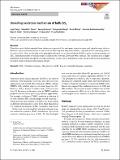Unveiling oxidation mechanism of bulk ZrS2
Author(s)
Yang, Liqiu; Tiwari, Subodh C; Jo, Seong S; Hong, Sungwook; Mishra, Ankit; Krishnamoorthy, Aravind; Kalia, Rajiv K; Nakano, Aiichiro; Jaramillo, R.; Vashishta, Priya; ... Show more Show less
Download43580_2021_Article_7.pdf (1.430Mb)
Publisher with Creative Commons License
Publisher with Creative Commons License
Creative Commons Attribution
Terms of use
Metadata
Show full item recordAbstract
Abstract
Transition metal dichalcogenides have shown great potential for next-generation electronic and optoelectronic devices. However, native oxidation remains a major issue in achieving their long-term stability, especially for Zr-containing materials such as ZrS2. Here, we develop a first principles-informed reactive forcefield for Zr/O/S to study oxidation dynamics of ZrS2. Simulation results reveal anisotropic oxidation rates between (210) and (001) surfaces. The oxidation rate is highly dependent on the initial adsorption of oxygen molecules on the surface. Simulation results also provide reaction mechanism for native oxide formation with atomistic details.
Graphic Abstract
Date issued
2021-02-02Department
Massachusetts Institute of Technology. Department of Materials Science and EngineeringPublisher
Springer International Publishing